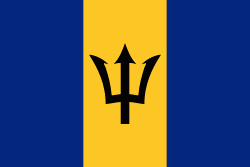Pelican Island (Pelican Island (historical))
Pelican Island was a small uninhabited island that once existed off the west coast of Bridgetown and Fontabelle, in St. Michael, Barbados.
According to historical record, the island received its name from brown pelicans (Pelecanus occidentalis) that would nest there. To get there, one could have used one of the pair of nearby boat jetties along the Barbados shoreline, or during low tide it was believed to have been possible to wade out to the island as well.
The island held a quarantine facility specifically for sick crew and passengers from ships, in order to prevent spread of infectious diseases to the mainland. There were housing facilities for patients, a morgue, a caretaker's quarters and a laundry area equipped with a cauldron for boiling clothes for sterilisation.
Over the five years of 1956 to 1961, a southwest section of the Atlantic Ocean between the island and Barbados was reclaimed and filled in during the building of the Bridgetown Port, and now Pelican Island has become incorporated into the mainland in the Bridgetown Deep Water Harbour complex.
According to historical record, the island received its name from brown pelicans (Pelecanus occidentalis) that would nest there. To get there, one could have used one of the pair of nearby boat jetties along the Barbados shoreline, or during low tide it was believed to have been possible to wade out to the island as well.
The island held a quarantine facility specifically for sick crew and passengers from ships, in order to prevent spread of infectious diseases to the mainland. There were housing facilities for patients, a morgue, a caretaker's quarters and a laundry area equipped with a cauldron for boiling clothes for sterilisation.
Over the five years of 1956 to 1961, a southwest section of the Atlantic Ocean between the island and Barbados was reclaimed and filled in during the building of the Bridgetown Port, and now Pelican Island has become incorporated into the mainland in the Bridgetown Deep Water Harbour complex.
Map - Pelican Island (Pelican Island (historical))
Map
Country - Barbados
 |
 |
| Flag of Barbados | |
Inhabited by Kalinago people since the 13th century, and prior to that by other Amerindians, Spanish navigators took possession of Barbados in the late 15th century, claiming it for the Crown of Castile. It first appeared on a Spanish map in 1511. The Portuguese Empire claimed the island between 1532 and 1536, but abandoned it in 1620 with their only remnants being an introduction of wild boars for a good supply of meat whenever the island was visited. An English ship, the Olive Blossom, arrived in Barbados on 14 May 1625; its men took possession of the island in the name of King James I. In 1627, the first permanent settlers arrived from England, and Barbados became an English and later British colony. During this period, the colony operated on a plantation economy, relying on the labour of African slaves who worked on the island's plantations. Slavery continued until it was phased out through most of the British Empire by the Slavery Abolition Act 1833.
Currency / Language
| ISO | Currency | Symbol | Significant figures |
|---|---|---|---|
| BBD | Barbados dollar | $ | 2 |
| USD | United States dollar | $ | 2 |
| ISO | Language |
|---|---|
| EN | English language |















